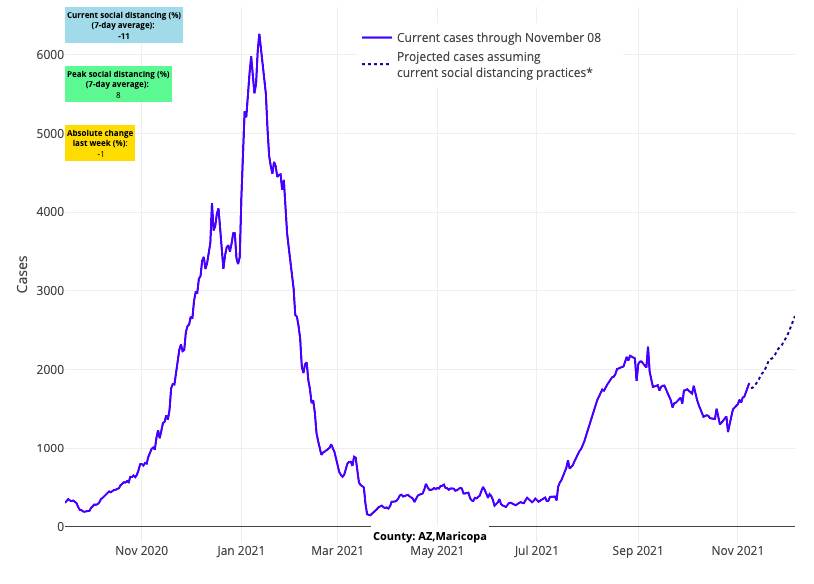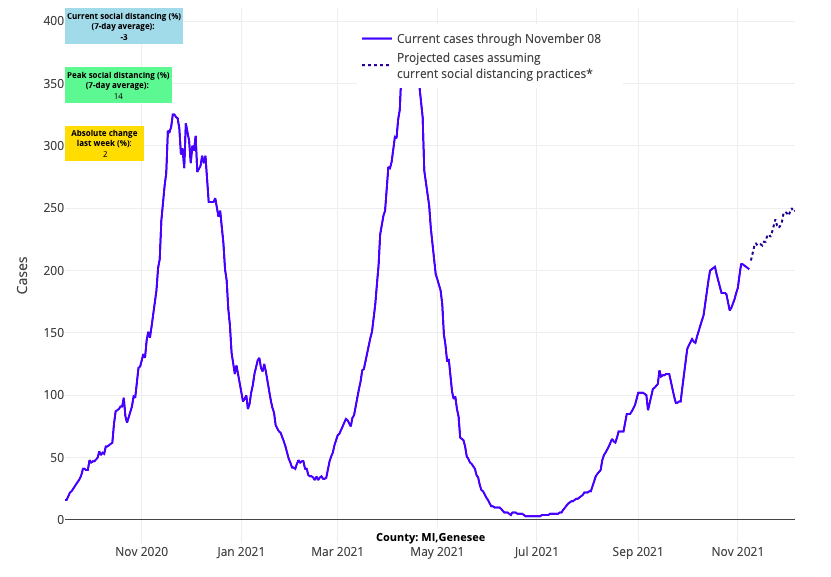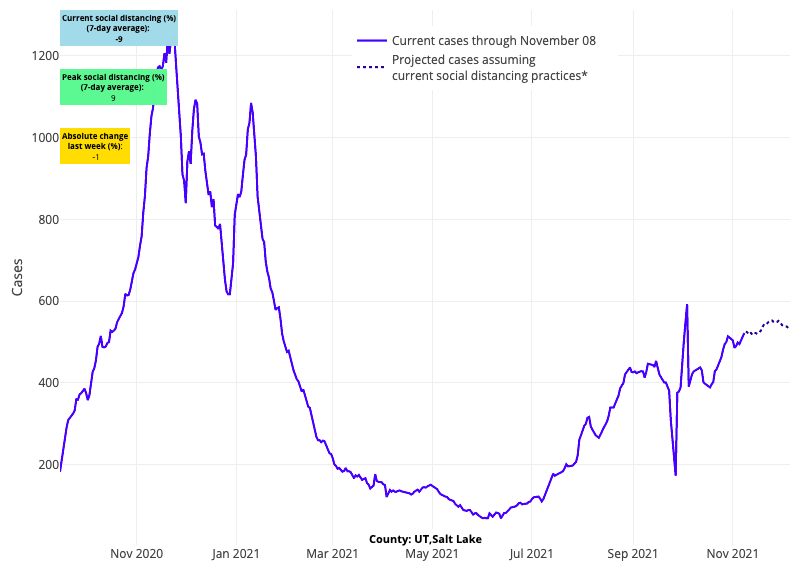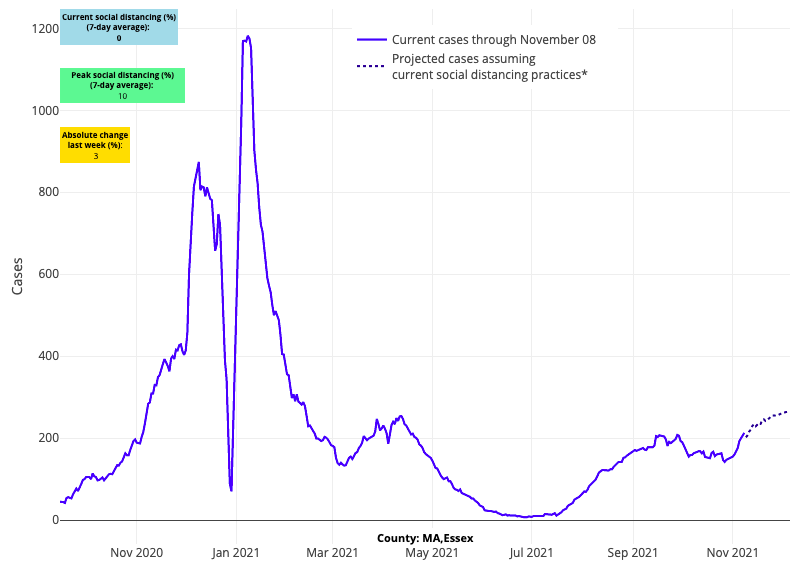COVID-19 Outlook: Seasonal Transmission Arrives Before Holiday Season
Now that we’re well into November, this week’s COVID-Lab modeling forecasts capture the nuance of differential state and county transmission patterns that will likely be the hallmark of this holiday season.
Here are this week’s national data updates:
- The national average PCR test positivity rate is 7.5% this week across the 812 counties we continue to follow, relatively unchanged from last week.
- The nation’s average reproduction number (a measure of transmission that estimates how many additional individuals, on average, will be infected by every positive case) is hovering near 1 again. Reproduction numbers increased in nearly two-thirds of counties this week compared to last week and nearly 40% of counties have reproduction numbers above 1, up from 15% of counties last week.
- The average case incidence is 179 weekly cases per 100,000 residents, relatively unchanged from last week. One-third of the counties we’re following are seeing more than 200 weekly cases per 100,000 residents, also unchanged from a week prior.
- States with the largest test positivity increases, on average across counties, include (in order) South Dakota, Arizona, Nevada, New Hampshire, Minnesota, Washington, Iowa, Wyoming, Ohio and Missouri.
- Adult hospital census continues to decline toward 40,000 individuals, with pediatric hospital census also declining from 800 to 600 children in the last couple of weeks. States where both adult and pediatric hospitalizations are growing include Colorado, Michigan, Minnesota and New Mexico.
Here are some noteworthy regional updates:
- Colorado counties continue to sustain increases in case incidence and hospitalizations. Case incidence has surpassed 600 weekly cases per 100,000 residents in Pueblo, has increased to 400 weekly cases per 100,000 residents in Colorado Springs and Fort Collins, and has reached 270 weekly cases per 100,000 residents in Denver (with higher rates in the Denver collar counties). The key difference among these counties: 50% of individuals in Pueblo are fully vaccinated, 60% of individuals in Colorado Springs and Fort Collins are fully vaccinated and 70% of individuals are fully vaccinated in Denver. Nearly 40% of Colorado’s ICU beds are occupied by COVID-19 patients, the highest level at any moment in the pandemic. Fortunately, our models this week forecast that case incidence will soon peak for Colorado counties, but this level of case incidence may be sustained for several weeks.
- Case incidence in and around Salt Lake City, where 60% of individuals are fully vaccinated, has exceeded 300 weekly cases per 100,000 residents, and our forecasts project continued increases over the next four weeks. Adult and pediatric hospital admissions have both increased across the state of Utah; adult hospital census remains as high as any prior moment in the pandemic.
- Our forecasts continue to project increasing case incidence in the coming weeks for the Phoenix region, where about 50% of individuals are vaccinated. Thus far, hospitalization numbers are far lower than at this time last year, but we would suspect the increase in case incidence will translate to rising hospitalizations as we approach Thanksgiving.

Above are the projections for Maricopa County in Arizona.
- Areas across the Midwest are reporting the highest reproduction numbers and transmission rates in the country this week. Most concerning is Michigan, where case incidence and hospitalizations are increasing quickly; our forecast for continued increases in case incidence for the state may translate into hospitalization peaks that match or exceed those of last winter.

Above are the projections for Genesee County in Michigan.
- Areas throughout upstate New York where full vaccination rates range from 50% to 65%—including Buffalo, Erie, Rochester and Binghamton—are seeing case incidence rates above 250 weekly cases per 100,000 residents, and our COVID-Lab forecasts project more growth into December. As New York City reaches 70% of all individuals fully vaccinated, their case incidence rates remain below 100 weekly cases per 100,000 residents.
- The well-vaccinated Boston region continues to hover well below 200 weekly cases per 100,000 residents and hospitalizations are slowly declining. This pattern is similar to other metropolitan areas along the I-95 corridor which, despite modest increases in transmission, are continuing to see flat or even declining hospitalizations. Our projections continue to forecast flat or only moderate increases in transmission in the coming weeks.
Northern and mountain areas combat growing transmission
We continue to be concerned for areas across Colorado that have sustained continued widespread transmission this week, accompanied by surging hospitalizations that are testing ICU capacity. Fortunately, our forecasts suggest counties in the state are nearing peak case incidence, but substantial incidence rates above 200 weekly cases per 100,000 residents will likely be sustained. Similar to Colorado, some northern states—such as Michigan, Minnesota and New Hampshire—continue to struggle and sit on precipitous footing entering the holiday season as large gatherings are likely to accelerate a challenging situation. Salt Lake City and Phoenix, where vaccination coverage is poor, also bear close watching in the weeks to come. Most other southern areas remain stable.

Above are the projections for Salt Lake County in Utah.
In more highly vaccinated regions, hospitalizations remain flat or even continue to decline, suggesting that hospitalization risk is decoupling from rising community transmission in areas with higher vaccination rates. This phenomenon also seems to be occurring throughout California, in Chicago and across major northeastern cities. We are even seeing flat hospitalizations in Minneapolis, where vaccination coverage is approaching 70%, despite case incidence reaching as high as 400 weekly cases per 100,000 residents. Elsewhere in Minnesota, where vaccination rates are lower, hospitalizations are rising.

Above are the projections for Essex County in Massachusetts.
Such evidence provides optimism that while transmission may persist in a given region with overall high vaccination rates, hospital impacts are likely to be less than previous periods of resurgence because of vaccine coverage. We say this cautiously, however, as colder weather is yet to arrive along the I-95 corridor and throughout the Midwest and Mid-Atlantic. Challenging days may still be coming for some of these regions, but with each week, the relative resistance to growing transmission and hospitalizations in more highly vaccinated areas adds confidence that these communities may avert the substantial impacts they saw at this time last year.
However, as we noted last week, even within more highly vaccinated communities, there is still the potential for clusters of transmission in poorly vaccinated neighborhoods. To this point, the experience around Minneapolis—specifically how substantial growth in hospitalizations will be—will provide insight for potential risk facing more poorly vaccinated Northeastern cities in the coming weeks. Continued efforts to optimize vaccination rates within these neighborhoods will prove valuable as we enter the winter.
Vaccinations continue to be the most effective strategy for blunting seasonal impact
Employer mandates, rising booster vaccinations and the initiation of vaccinations to elementary-age children will serve to further blunt impacts in many locations this coming winter. While vaccine mandates for public employees in Californian cities and across the Northeast have been controversial, they quickly increased vaccination rates and have likely contributed to the flat or falling case incidence in New York City and Los Angeles.
Likewise, we encourage parents to see the value that prompt vaccination of younger children can have for a safe, healthy holiday season. A recent Kaiser Family Foundation poll found that only one-third of families planned to vaccinate their younger children immediately, while another third are taking a wait-and-see approach. The final third of families do not plan to vaccinate their young children. For those waiting, we would note that case incidence rates are still high enough in all areas of the country to pose a continued risk of exposure to these children now and likely throughout the winter. Vaccination of young children now makes the most sense, to protect them from exposures that will continue throughout the winter. Vaccinating children now will reduce the potential that they will serve as a source of transmission to other vulnerable family members at the holiday table. This pandemic has already accounted for over 750,000 fatalities in our country. We have the opportunity through vaccination of all eligible adults and children to continue to stamp out the flames of this pandemic and stop the death toll from climbing higher.
Informing family members and parents of younger children about the protection that vaccination can bring this season can assure that we enter a new year that is much brighter than the last two years.

